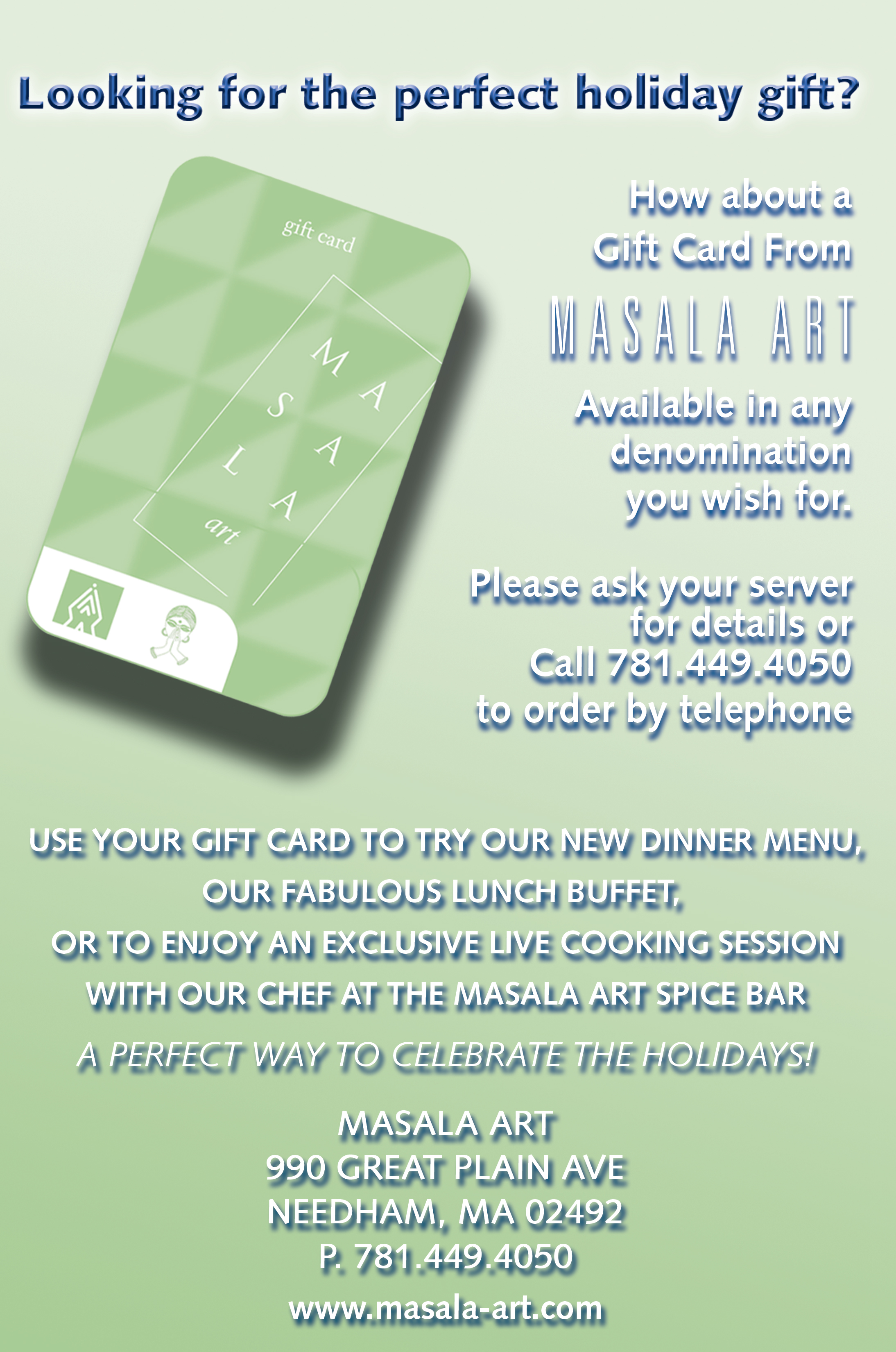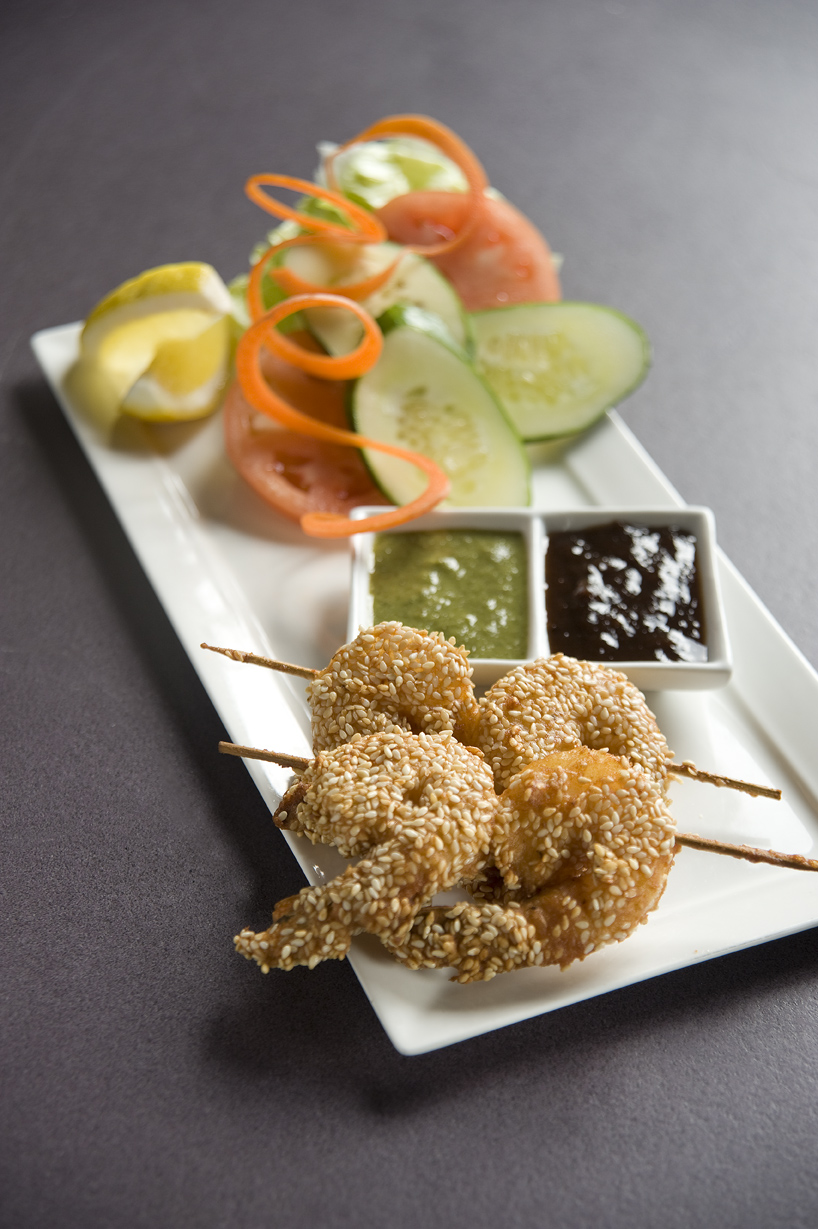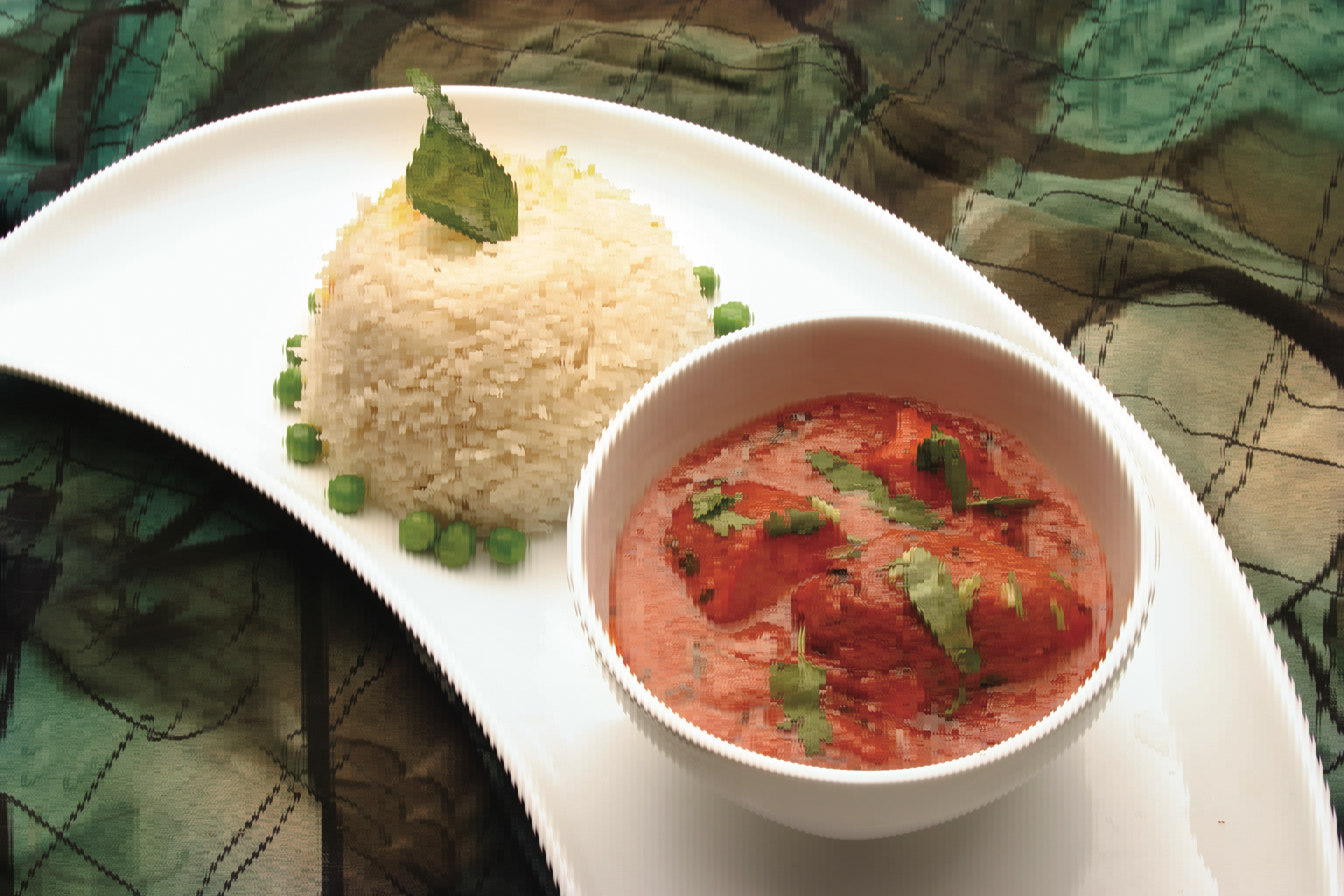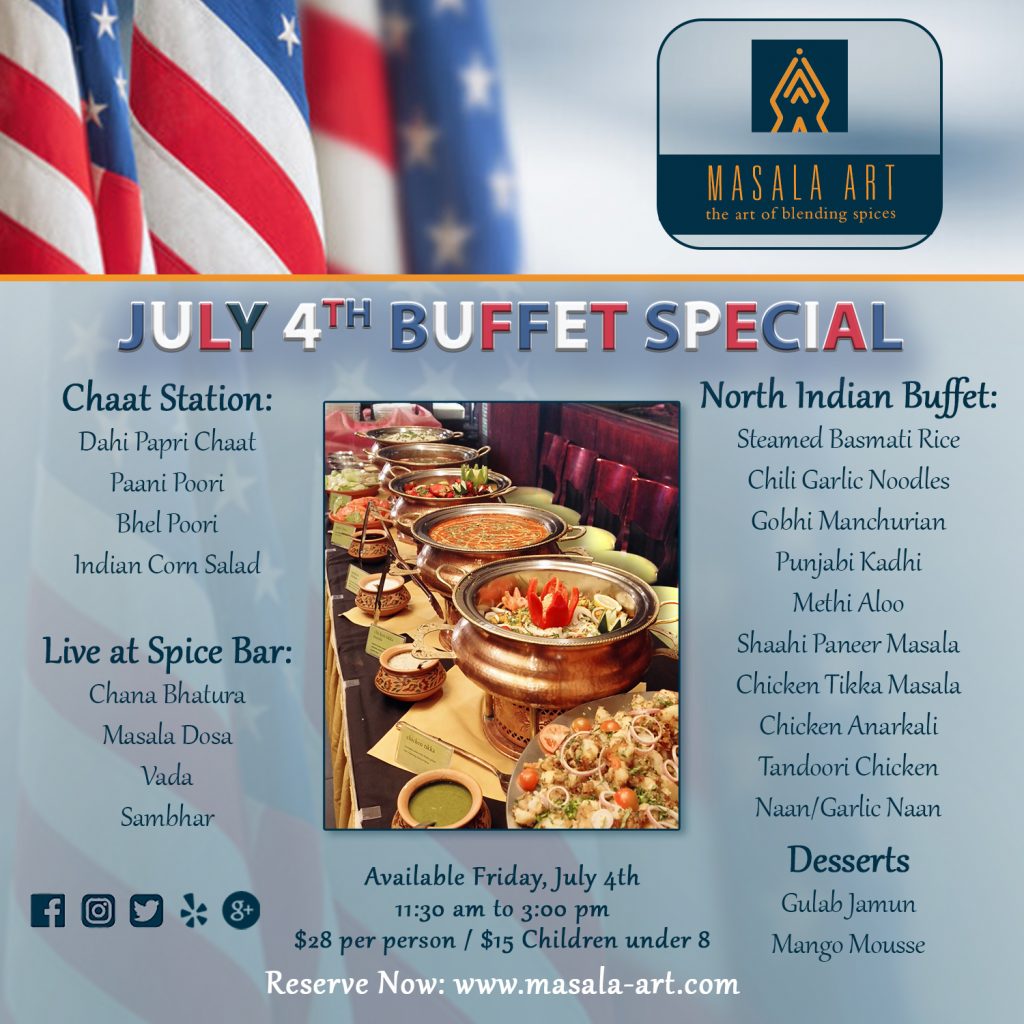
Still Looking for a Holiday Gift?


Masala Art has introduced a brand new and expanded Dinner Menu with over 50 new and delicious selections to experience. Our family and culinary team have worked extensively and enthusiastically to bring our guests the finest in regional Indian selections, many of which are unique to our restaurant. We pride ourselves on these culinary innovations and hope that you will enjoy them as much as we did in developing them.
We have introduced plenty of healthy vegetarian, vegan and gluten free options – Try the healthy South Indian Green Beans Poriyal or Beet Root-Paneer Tikki. In addition, all of our non-vegetarian selections are now prepared Halal for our guests to enjoy. For our meat-lovers, the Masala Braised Lamb Shanks are sure to be a favorite!
Please Click Here, for Full Menu Details and Item Descriptions.
Here are some new menu features and recommendations:
With this menu, Masala Art truly delivers aromatic and complex flavors carefully selected from all over the Indian sub-continent. This menu took over a year for our executive and culinary team to develop. Our ideas are original and unique. We are excited to offer our guests these novel and innovative varieties.
My personal favorites so far are the Masala Braised Lamb Shanks, Chickan Dostana, Chicken Lababdar and Hydrabadi Sukha Mutton Curry. Hope to see you soon at Masala Art so that you can tell us your new favorites!
Sorabh Kapoor
Manager
Masala Art
by admin

Wishing you a Happy Diwali & Prosperous New Year from Masala Art!
Diwali is the Indian festival of lights. Diwali commemorates the return of Lord Rama, along with Sita and Lakshmana, from his 14-year-long exile and vanquishing the demon-king Ravana. In joyous celebration of the return of their king, the people of Ayodhya illuminated the kingdom with earthen diyas and by bursting firecrackers. For Hindus, Diwali is one of the most important festivals of the year and is celebrated with family and friends by performing traditional prayers and holding small get togethers in their homes.
Join us for our Special Diwali Dinner Buffet!
Thursday, October 23, 2014
5:00 to 10:00p
Dinner Buffet $25 per person + 7% tax
$12 per child between the ages of 6-12
For Reservations, Please Call: 781.277.6571
Chaat station
Chaat is a nutritious roadside snack found in Northern India.
Choose your own toppings and fillings and create your own Chaat!
Chaat Papri
Paani Poori
Corn Bhel
Appetizers
Beet Root Tikki
Soya Skewers
Indian Chinese Chili Paneer
Dinner Buffet
Basmati Rice
Steamed Basmati Rice
Punjabi Kadhi
Ras Missay Aloo
Palak Paneer
Madras Chicken
Lemon Lamb
Fresh Breads: Naan & Poori
Mint Raita
Achaar
Desserts
Jalebi
Badami Kheer
Our new website is finally up. We’ve worked hard to get a beautiful new site ready and we’re proud to show it off. Thanks for reading our blog. We have lots of great blog posts in the works. Please check back or contact us now to find out how we can help you.
by masala art
Regional Indian Cuisine.
India is a vast land of many different cultures, religions and beliefs and is depicted through art, food and entertainment. India is made up of 28 states. There are 22 different officially spoken languages in India along with thousands of local dialects. One can travel from village to village and find different languages being spoken, styles of clothing being worn, and of course many varieties of food. Historically, has many distinct and unique dishes highlighted by its region or origin. The menu at Masala Art reflects many regions of India. Let’s take a journey through Hyderabad and how its cuisine was founded and presented in modern day Indian Restaurants.
Hyderabadi Indian Cuisine.
Hyderabadi Cuisine is one of the most unique ways of preparing Indian foods. To prepare it, one must study the art of blending spices carefully, as each spice has a purpose, aroma and flavor profile that is specific to the type of dish being prepared. The timing in which the spice is introduced and length of time they are simmered for, are equally important. Timing is everything in Hyderabadi cooking and typically, one needs a lot of it. The key word when referencing Hyderabadi cooking is “slow.”
History of Hyderbadi Cuisine
Hyderabadi Cuisine was developed after the foundation of Qutb Shahi dynasty by Sultan Quli. Hyderabadi cuisine had become a royal legacy of the Nizams of Hyderabad State. Its eclectic style is reminiscent of Mughlai, Turkish and Arabic with a heavy influence of the native Telugu and Maharashtra Cuisines. Hyderabadi cuisine comprises of a broad collection of rice, wheat and meat dishes along with the skilled use of various spices and herbs.
The cuisine emphasizes on the use of ingredients that are carefully chosen and cooked to the right temperature and time. Utmost attention is given to picking the right kind of spices, meat, and rice, thereby producing a distinct taste and aroma. The key flavors are of tamarind, coconut, cardamom, saffron and cloves, which are extensively used in many dishes. The key difference from the North Indian cuisine is the presence of dried coconut and tamarind in its cuisine.
Method of Cooking
Traditional utensils made of copper, brass, and earthen or clay pots are used for Hyderabadi cooking and involve the direct use of fire. There is a saying in Hyderabad, cooking patiently or “ithmenaan se” is the key; slow-cooking is the hallmark of Hyderabadi cuisine. The slow and sealed method of cooking is called the “Dum Pukht” method. Hyderbadi dishes are prepared in large copper pot called a handi, covered with a thin bread seal to maintain the aroma of the spices and tenderness of the meat or vegetables being prepared. Masala Art has adapted many of these cooking methods and enhanced them to match its modern day restaurant setting, which keeping the tradition and authenticity of the food.
Influences
Hyderabadi cuisine has evolved over centuries from foreign and native influences. The cuisine began to form during the medieval times and was reached to extend during modern period through the work of skilled chefs serving the Deccan nobility. The city of Hyderabad being the seat of former Maharajas, was the center of many innovative techniques led by Khansamas, royal chefs, that eventually gave form to modern Hyderabadi cuisine.
The modern cuisine was evolved during the Nizams in the mid-17th century, and elevated to a inspiring art form. Hyderabad had a history of constant influx of migrants from all over the world and in general from the Indian sub-continent, particularly since the 1850’s. Most of the foreign food had been enhanced to suit the culinary preferences, resulting to form the unique derivative cuisine that excels over the original. Biryani (Turkish) and Haleem (Arabic) for instance is prepared all over India, but the Hyderabad has its own exceptional variety.
Popular Hyderabadi Preparations
The herbs and spices used in the dish as well as the method of preparation gives the dish its name. For example, Murg do Pyaaza is named so because Onion (‘Pyaaz’) is added to the dish twice, in different variations.
Hyderabadi Haleem is a high calorie preparation often prepared specifically to break the Ramadan fast. Haleem means patience, because it takes long hours to prepare (upto an entire day) and served in the evenings.
Hyderabadi Biryani is Hyderabad’s most famous meat-and-rice dish. Just like the many variations in Northern Indian Mughlai dishes, there are at least 25 variations of biryanis. An authentic Hyderabadi meal invariably includes a goat meat biryani which is coincidentally Masala Art’s most popular rice concoction and is served at many weddings and catered events. Other variations can also be prepared by incorporating chicken, lamb, or vegetables instead of goat or mutton.
by masala art
Indian weddings can be very extensive and grand celebrations. There are often three or four individual events, and some traditions can have more than a dozen separate events. All of this leads up to the union of not only the bride and groom, but also their families. As such, many meals are shared between these families and the guest count can easily number into the hundreds. One option is to try cooking for all those people in your own kitchen, or you could hire a catering service. Just be sure the caterer serves the best Indian food using only traditional Indian spices that will match with the tradition of the wedding ceremony you are planning.
Open the phone book and you will find dozens of wedding catering services throughout New England. However, you’re not just looking for any wedding caterer, you need someone that can prepare traditional Indian cuisine. Additionally, you need to find someone that has a reputation for preparing the best Indian food. Basically, you’re looking for the best Indian cuisine in the Greater Boston area.
Now that you’ve narrowed your search down to only Indian catering services, it’s time to see who has a restaurant in the area. This is a good indication that the caterer will prepare excellent Indian food. Caterers that do not have a local restaurant may or may not be able to deliver a quality product. Having a local restaurant shows the caterer consistently prepares great dishes and it give you a chance to try their cuisine before you hire them to cater such an important event. While you are tasting their food, you can also ensure they prepare authentic dishes using traditional Indian spices. There’s only one place in Greater Boston that consistently delivers high quality authentic Indian food using traditional spices. That is Masala Art.
You’ll find the best option in Boston is the contemporary Indian restaurant & bar, Masala Art. Masala Art, owned by Shakila & Vinod Kapoor, has been delighting the people of Suburban Boston with the spices of India for many years. With 33 years of experience, the Kapoor family’s expertise in Indian food catering is an extension of the great food and service provided in the restaurant. With glowing reviews from The Boston Globe, Needham Times, The Needham Patch and weddingwire.com, it’s easy to see why so many people say Masala Art offers the best Indian food in Boston.

A tandoor is a clay oven, it fact it is basically almost like a very large clay pit, large enough to hold a small fire created by slow burning wood charcoal. The heat is controlled by the amount of oxygen that is let in or out of the pit. Many tandoori ovens have a small door or window at the bottom which is opened or closed to let in oxygen. The direct heat of the charcoal fire is reflected by the ceramic walls of the tandoor intensifying the heat and creating a cooking environment that easily reaches 600 degrees F. Marinated meats are lowered into the oven on long metal skewers and cooked in this smoky and extremely hot “pit” until they are grilled to perfection.
The marinade used in almost any tandoori dish starts with yogurt. While this might sound a little strange this is actually perfect for marinating meats because it has a natural acidity and it is thick so it surrounds and holds to the meat well and keeps the herbs and spices in place. The flavor of the yogurt (always plain) is so mild you typically don’t even taste it, but does an amazing job of penetrating the meat and holding the flavors of each spice in.
In addition to the colors provided by the spices, tandoori marinades are also flavored traditionally with ginger, garlic, coriander powder, cayenne pepper, and garam masala. Garam masala is a combination of roasted and ground cardamom, cumin, cinnamon, cloves, nutmeg and black pepper. This spice mixture is great on practically anything because it imparts a mellow but savory flavor to whatever you use it on. You can adjust the spiciness of your tandoori dish by adding more or less cayenne pepper.
So, after you have combined your spices and yogurt, got the right color and spiciness, immerse the meat into it. You want meats to sit in this thick marinade for several hours to absorb the flavors. Now you are ready to hit the grill. Remember that tandoori is cooked at very high temperatures and while you probably don’t have a tandoor in the backyard your barbeque grill will do the job perfectly. Get your grill as hot as you can and keep it closed as much as possible. You want to start out at a high temperature and keep it that way. Lift the lid only long enough to get the meat on the grill and to keep a close enough eye out to prevent burning.
Tandoori cooking can be a very healthy and easy way of preparing foods. The trick to using a tandoor or charcoal heat is that making sure the heat hits the meat immediately. The combination of the yogurt, the natural juices of the meat and the intense heat created by the charcoal fire, ensures that the natural fats of the meat are sealed within the meat immediately. This creates a nice flavor without having to use or add external fats such as butter or oils.
Chicken Curry
Serves: 6 to 8
5 lbs dark meat chicken (boneless cut into 2 inch pieces)
5 Tablespoon vegetable oil
4 medium sized onions finely chopped
4 medium sized tomatoes finely chopped
5 tablespoons tomato puree
½ teaspoon cumin seeds
1 stick cinnamon
1 inch piece of ginger finely chopped
1 teaspoon minced garlic (ready made)
3-4 pcs. Cloves
1-2 bay leaves
½ teaspoon garam masala
2 tablespoons of chopped cilantro for garnish
½ teaspoon chili powder
2 ½ cups water
Salt to taste
In a heavy skillet, heat the oil and sauté the onions and cumin seeds, cinnamon sticks cloves, bay leaves. Add chopped ginger and minced garlic. When the onions are golden brown add chopped tomato and tomato puree and cook this mixture for 4 to 5 minutes. Add chicken pieces and cook through. When chicken gets tender add 2 ½ cups of water and let it boil. After it starts boiling, reduce heat and simmer for 5 to 7 minutes. Add garama masala for flavor and garnish with cilantro. Serve hot with Basmati rice.
BAIGAN BHARTHA
Serves: 6 to 8
2 large eggplants (1 1/2 pounds)
1/4 cup plus 2 Tablespoons vegetable oil
1/2 teaspoon cumin seeds
1 bay leaf
3 medium onions, finely chopped
3 tomatoes finely chopped
1 teaspoon red chili powder
1 teaspoon dried coriander
1 /2 Teaspoon garam masala
3 Tablespoon tomato sauce (Hunts)
Chopped fresh coriander for garnish
Using a pair of tongs or a long handled fork, hold the eggplant by the stem over an open flame to char the skin. When skin blackens, place eggplant on a plate to cool. When the eggplant is cool enough to handle, peel the skin off and place the pulp in a medium bowl. Mash it with a fork until it is puréed. Set aside.
Heat the oil in heavy pan over medium heat. When the oil is hot, add the chopped onion, cumin seeds and bay leaf. Sauté until the onions are golden brown. Add chopped tomatoes, chili powder, garam masala, dried coriander and salt to taste. Cook the mixture until the tomatoes are soft. Add the tomato sauce and the puréed eggplant and cook for 5 to 7 minutes or until eggplant and spices are well-blended. Garnish with chopped coriander and serve hot with chapati bread.
ALOO KATLIYAN
Serves 6 to 8 People
Ingredients:
For Tomato Sauce:
2 Onions Peeled and chopped
3 Tomatoes Chopped
1 / 2 Stick Cinnamon
1 Gram Cumin Seeds
1 Gram Coriander Seeds
5 cloves Garlic and 1 inch pieces of Ginger (grinded together to a paste)
1 gram Turmeric Powder
1 gram Dried Fenugreek
1 gram Chili Powder
2 tablespoons Vegetable oil
Salt to taste
For Cashew Paste:
20 pieces Cashews Blanched
5 cloves Garlic and 1 inch pieces of Ginger (grinded together to a paste)
1 / 3 Cup Yogurt
1 / 2 gram Green Cardamom Powder
1 / 2 gram Mace Powder
2 Bay Leaves
1 gram Green Chili chopped
1 gram Fresh Mint Chopped
1 gram Cilantro Chopped
Salt to taste
For Potatoes:
3 Medium Sized Russet Potatoes Peeled
1 / 2 Teaspoon Turmeric Powder
1 / 2 Teaspoon Salt
1 teaspoon of lemon juice
5 Cups Water
For Garnish:
1 Tablespoons of Fresh Cilantro Chopped
1 Green Bell Pepper (Deseed and cut into rings)
5 thin strips of ginger (1 inch in length)
Step 1 – To make Tomato Sauce:
In a frying pan, combine oil, cinnamon sticks, cumin seeds and coriander seeds. Add chopped onions and as they start to brown add ginger-garlic paste. Add turmeric powder, chili powder, salt, and chopped tomatoes. Keep the mixture aside.
Step 2 – To make Cashew Paste:
Boil cashews in 1 / 2 cup of water and grind into a slightly thickened paste. In a frying pan add oil, ginger-garlic paste, grinded cashews and yogurt. Then add cardamom powder, mace powder, bay leaves, salt and green chilies. Mix the tomato sauce, cashew paste, fresh ginger strips, chopped mint, cilantro and salt.
Step 3 – To make Potatoes:
Cut the peeled potatoes into thin round slices (1 / 8” thick). Boil 5 cups of water along with salt, turmeric powder and lemon juice. Add the slices of potatoes to boiling water and blanch for 3 minutes. Drain water and dry with paper towel. Shallow fry potato slices with vegetable oil on a griddle until crispy. Put ready sauce on top of each slice of crisp potato. Garnish each potato crisp with fresh chopped cilantro and bell pepper rings. Makes a great appetizer!
